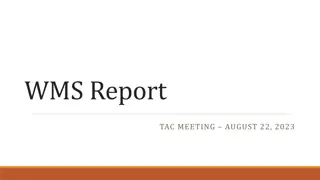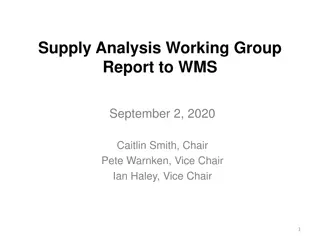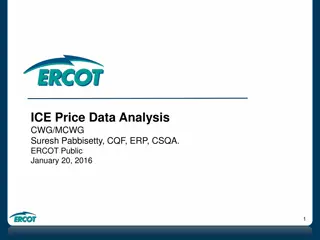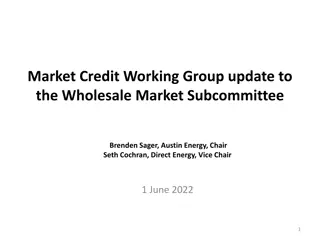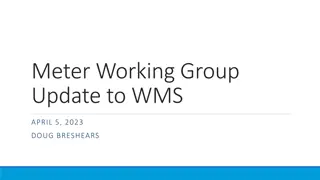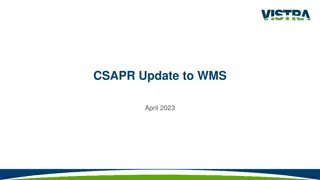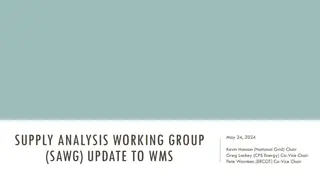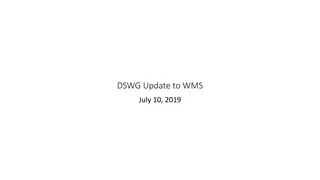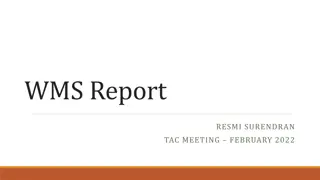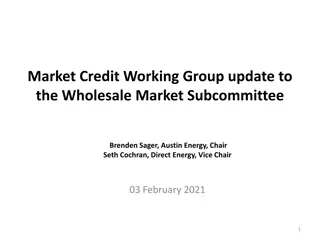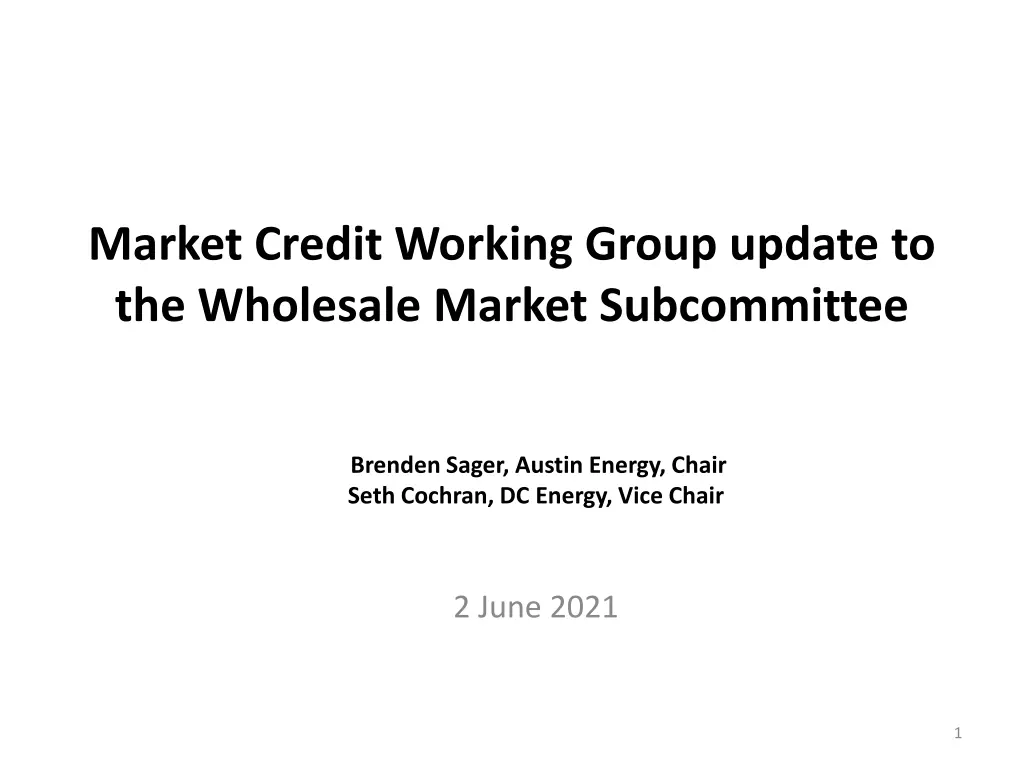
Wholesale Market Credit Working Group Updates and Discussions
Stay updated on the latest developments from the Market Credit Working Group as they review NPRRs for credit impacts, discuss default allocation concerns, and delve into uplift discussions. Explore valuable insights and recommendations for the Wholesale Market Subcommittee.
Download Presentation

Please find below an Image/Link to download the presentation.
The content on the website is provided AS IS for your information and personal use only. It may not be sold, licensed, or shared on other websites without obtaining consent from the author. If you encounter any issues during the download, it is possible that the publisher has removed the file from their server.
You are allowed to download the files provided on this website for personal or commercial use, subject to the condition that they are used lawfully. All files are the property of their respective owners.
The content on the website is provided AS IS for your information and personal use only. It may not be sold, licensed, or shared on other websites without obtaining consent from the author.
E N D
Presentation Transcript
Market Credit Working Group update to the Wholesale Market Subcommittee Brenden Sager, Austin Energy, Chair Seth Cochran, DC Energy, Vice Chair 2 June 2021 1
MCWG update to WMS General Update 22 July 2021 Joint MCWG/CWG WEBEX Meeting 2 NPRRs reviewed for their credit impacts, 1083 and 1073 1083NPRR Modification of Uplift Allocation Rules to Address Role of Central Counter-Party Clearinghouses. Credit WG reviewed Nodal Protocol Revision Request (NPRR) 1083 and determined that it would not require changes to the credit methodology. It will reduce the Counter-Parties that would be subject to the default uplift, and therefore could increase default uplift amounts and credit requirements for Counter- Parties not covered by the exemption. This NPRR is in compliance with the SBs 3, 1580 & HB 4492. 2
MCWG update to WMS Review NPRR 1073 Market Participant Application Changes On July 21, 2021, the Credit WG again reviewed Nodal Protocol Revision Request (NPRR) 1073. The Credit WG believes this NPRR will provide positive credit impacts and is consistent with the ERCOT filing at the Public Utility Commission of Texas (PUCT) regarding implementation of default allocation rules. Credit WG supports the additional revisions within the 7/6/21 Luminant comments, but notes the need for a subsequent NPRR to address the appeal process for Entities deemed to be Principals under NPRR1073. 3
Default Allocation Discussion Concerns about CRR calcs in MW s versus dollar-based Defaults should be allocated among MP types (load/gen/CRR) or public/private/government Public power might be segregated in terms of defaults; Competitive MP s would have their own defaults Get away from MW allocation to more gross values based on invoice/settlement Too much default allocation to CRR market Not a good idea to send default activity to the forward hedging market and creating disincentives to do hedge 4
Uplift further discussion Consider using dollar-based activity approach versus ERCOT s MW- based approach For example, a purchase of 100 MW at a price of $100, phys buyers are credited with 100 MW of Market Activity someone purchasing 100 MW of CRRs with a price of $0.50 is also credited with 100 MW of Market Activity. CRR purchasers are penalized with their $50 of activity treated the same as $1,000 of energy Value driving this CRR s are disproportionately low Uplifts driven by cash invoices are better; CRR s are being hit hard Invoices net dollar amounts Note: example reflects case where CRRs clear much less per MW than energy because CRRs are the cost of congestion 5
Uplift further discussion Important to establish cap on default uplifts Wanting to protect market from second wave defaults after uplift put to the market Try to spread out defaults among market but large default (currently $3.0B total) difficult to address Consider dividing uplifts among MP s based on type (load, generation and CRRAH) Seth Cochran details other ISO s on their practices 6
ISO/RTO Default Allocation Practices ISO/RTO Default Allocation Practices ERCOT MISO SPP CAISO PJM Activity base used in default allocation: Based on previous month Max activity buckets: Based on invoice activity during the same period of time as the unpaid invoice(s) of the MP whose unpaid Past Due Amount has been declared an Uncollectible Obligation. Based on Invoice activity during the same period of time as the unpaid invoice(s) of the MP whose Unpaid Obligation has been declared an Uncollectible Obligation. Hybrid approach based on dollar and MW activity: Activity component is based on on last three months gross activity Based on quarterly percentage shares calculated based on quarterly average over rolling four- quarter look-back period: Default Allocation Assessment shall be equal to (0.1(1/N) + 0.9(A/Z)) -Metered -- Generation/DCT Imp -Metered Load -Bilateral sales -Bilateral purchases -DAM sales -DAM purchases -CRR Sales & ownership in DAM -CRR Auction Purchases The Uncollectible Obligation is allocated to all Non-Defaulting MPs who conducted business in the market during the time covered by the invoice(s) containing the Uncollectible Obligation(s). Allocated to each MP that had been invoiced during the same period of time as the unpaid invoice(s) of the MP whose unpaid Past Due Amount has been declared an Uncollectible Obligation. Dissection of calculation: 20% of payment default amount allocated in proportion to net amounts payable 1) % share to total number of participants weighted at 10% (not exceeding $10,000); and =% Loss for MPA = MPA Market Charges + Market Credits in weekly invoicing cycle/ MPALL (Market Charges + Market Credits) in weekly invoicing cycle. % Loss for MPA = MPA Market Charges + Market Credits in weekly invoicing cycle/MPALL (Market Charges + Market Credits) in weekly invoicing cycle 30% of payment default amount allocated in proportion to sum of absolute values of dollar amounts shown on invoices payable or receivable after certain dollar amount exclusions for GMC, RMR, and Wheeling Access Charge costs and exclusions for billing of Access Charges and payment of Transmission Revenue Requirements to Participating Transmission Owners 2) % share to total market over last 3 months weighted at 90% A = for Members comprising factor "N" above, the Member's gross activity as determined by summing the absolute values of the charges and credits for each of the Activity Line Items identified in section 15.2.2(b) below as accounted for and billed pursuant to Operating Agreement, Schedule 1, section 3 for the month of default and the two previous months. -Loss Obligation of MPA = ((% Loss for MPA) x $ Amt of Uncollectible Obligation) minus (- ) (Reduction of Payments + Pro rata share of partial payment(s)) Loss Obligation of MPA = (% Loss for MPA) x $ Amt of Uncollectible Obligation, where: MP = Market Participant -Market Charges = The absolute value of all charge amounts associated with invoices for Market Activities. -Market Credits = The absolute value of all credit amounts associated with invoices for Market Activities. -MPALL = All Market Participants other than MPs with Uncollectible Obligations. Where: -MP = Market Participant --Market Charges = The absolute value of all charge amounts associated with invoices for Market Services. -Market Credits = The absolute value of all credit amounts associated with invoices for Market Services. -MPALL = All Market Participants other than MPs with Uncollectible Obligations. -Reduction of Payment = The amount of the Unpaid Obligation originally assessed to MP -Pro rata share of partial payment(s) = Any partial payments received during cure period Z = the sum of factor A for all Members excluding ex officio Members, State Consumer Advocates , Emergency and Economic Load Response Program Special Members , and municipal electric system Members that have been granted a waiver under Operating Agreement, section 17.2. 50% of payment default amount allocated in proportion to largest of the following amounts calculated in MWh for every month in each applicable calendar quarter Cleared DA Schedules to supply Energy Metered Generation Cleared DA Schedules for demand Metered Load x 103%... The greater of the quantity of CRRs or Inter-SC Trades of Energy Default Uplift Billing Timeline no earlier than 90 days no prescribed timeline next practicable invoices
MCWG update to WMS Market-wide average TPE increased from $ 594.12 million in May to $ 610.6 million in June TPE increased mainly due to higher Forward Adjustment Factors on 06/15/2021 and higher Real-Time prices 06/13/2021 and higher Day-Ahead prices on 06/15/2021 Discretionary Collateral is defined as Secured Collateral in excess of TPE,CRR Locked ACL and DAM Exposure Average Discretionary Collateral increased from $1,230.5 million to $1,791.3 million The increase in Discretionary Collateral is largely due to increase in Secured Collateral. Short pay entities are excluded from the above calculations to remove data skew No unusual collateral call activity 8
Available Credit by Type Compared to Total Potential Exposure (TPE) June 2020- June 2021 * Numbers are as of month-end except for Max TPE 10

